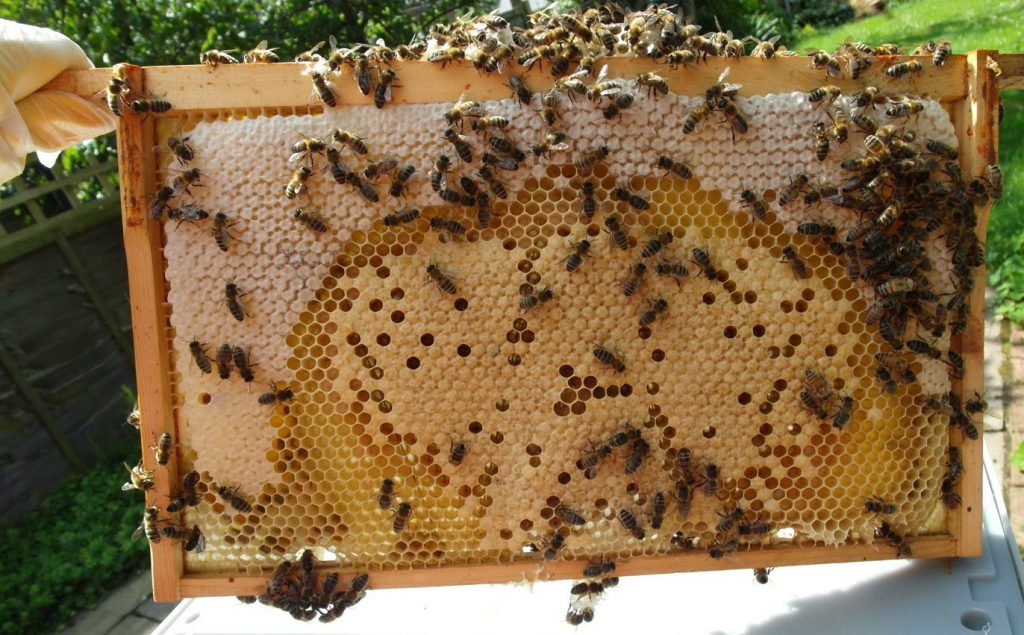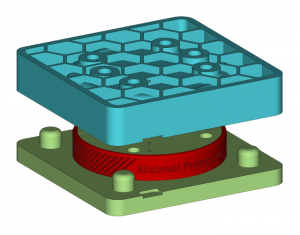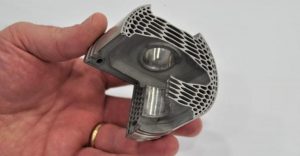
In the hive, honeycomb is used for the storage of honey and pollen as well as for the rearing of brood. (Image credit: Tanya Weaver)
Although famously known for producing honey, bees are also master wax producers and beekeepers like me will (given the chance) wax lyrical about how ingenious these tiny engineers are in creating their homes.
Each waxy cell is a perfect hexagon and it is this repeating pattern of six-sided figures that is seen in a cross-section of a honeycomb. The bees, of which there can be more than 50,000 in a colony, will use this comb for storing honey, pollen as well as for rearing brood.
Of course, nowadays beekeepers give bees a helping hand (or, rather, force them) to create their homes in predominantly square boxes with removable frames containing wax foundation that the bees will draw their cells out from. But, left to their own devices, their homes are still beautiful structures but not as easy for beekeepers to manage. In the wild they could make a nest inside of a wall or three hundred feet in the air attached to rocks.
But why hexagonal cells? Although humans have known it for years, it was only in 1999 that the American mathematician Thomas Hales finally proved that the hexagon is indeed the most efficient pattern for the storage of honey. It’s a structure that maximizes storage space and minimizes material required. Indeed, honeycomb can support 40 times its own weight in honey. Clever bees!
But before we give all the credit to these mini mathematicians, Jürgen Tautz in his book The Buzz about Bees: Biology of a Superorganism (which I highly recommend adding to your ‘to read’ list), explains that the cells are initially constructed as cylinders. The bees use their bodies as a template as they begin to build the walls of the cells and it’s only as the cells are filled, stepped on and come into contact with other wax cells that they ‘balloon out’ into a hexagon shape. Clever nature!
Indeed, inspired by nature in what is termed biomimicry, we see honeycomb structures all around us in various architecture, engineering and scientific applications, including the aerospace industry, where material and weight needs to be reduced but strength preserved.
In 3D printing, the honeycomb is also a familiar structure, particularly for infills. 3D printed objects are typically not 100% solid and are instead held together by a lattice structure called an infill. Most 3D printed parts on FFF (FDM, Material Extrusion) 3D printers are only 20 to 30% full. Infills play an essential role in the overall strength of an object, connecting the outer shells and supporting the upper surfaces too.

In this image, the makers of the Gigabot 3D printer, demonstrate three infill patterns (rectilinear, triangular and honeycomb) at varying density percentages.
The specific infill pattern and density will affect the strength of the finished part. Higher infill densities will, of course, make an object stronger, but will use more material, take longer to print and cost more. The secret to successful use of infill is to find the sweet spot where sufficient strength is obtained for an object’s designed purpose.
Honeycomb or hexagonal infill is generally considered to be the most commonly used and strongest infill pattern. It provides greater overall strength in all directions than a rectangular pattern, for example, with very little increase in print time.
The infill’s designated percentage and pattern are set in the slicing software. Almost all slicing software such as slic3r, Simplify3D, and Cura provides six options for infill patterns. In CAD or through the MakerBot Desktop Software, however, users can make custom designs, which look good but are not always practical.

As a beta tester of Materialise Magics 22, service bureau Midwest Prototyping was able to reduce volume on its 3D printed master patterns used for silicone casting.
On the theme of honeycombs, earlier this year Materialise Magics, data preparation and STL editor software for 3D printing, released a new honeycomb structures feature in Materialise Magics 22. Materialise claim that this new method can create much lighter 3D prints without compromising structural integrity and functional use.
From prototypes and moulds, honeycomb structures are showing potential for use in functional, end-use products too. For instance, Berlin-based IAV Automotive Engineering is using metal 3D printing to create a new type of piston for commercial vehicle engines that features a super-strong honeycomb lattice.

With the honeycomb lattice replacing the solid material within a piston, IAV Automotive Engineering says that mass has been reduced by about 25% from the traditional casting process.
According to the company, “Besides lower emissions, the trend for commercial vehicle engines is also moving towards higher pressure levels in the combustion chamber which increases specific power output. To cope with loads of up to 300 bar, IAV’s designers have provided the new piston with a honeycomb structure which is light in weight and extremely strong at the same time.”
Meanwhile, another Berlin-based company, BigRep, recently presented its 3D printed, full-scale airless bicycle tire. The tire prototype was printed on the company’s BigRep ONE large-scale 3D printer using its Pro FLEX filament, which is flexible and durable yet resistant to high temperatures.
According to BigRep’s product designer Marco Mattia Cristofori, “We were able to replace ‘air’ as a necessity in the tire by customizing the pattern to be one of a three-layered honeycomb design. Based on the same principle, the design can be altered to fit the requirements of specific kinds of biking, such as mountain biking and road racing, or for different weather and speed conditions. Perfecting the design is the trickiest part.”
Back to the original engineers of the honeycomb, the bees, and it’s not only the hexagonal structure that is fascinating but the wax material too. It’s produced from four pairs of wax glands located on the underside of the bee’s abdomen. The wax appears in small scales or flakes and then chewed by other bees to form a malleable wax. Not an ounce is wasted and all put to use for the greater good of the hive. There is a lot we can learn from bees!
Subscribe to Our Email Newsletter
Stay up-to-date on all the latest news from the 3D printing industry and receive information and offers from third party vendors.
You May Also Like
Precision at the Microscale: UK Researchers Advance Medical Devices with BMF’s 3D Printing Tech
University of Nottingham researchers are using Boston Micro Fabrication‘s (BMF) 3D printing technology to develop medical devices that improve compatibility with human tissue. Funded by a UK grant, this project...
GaeaStar and Verve Coffee Roasters Start Pilot Production of Sustainable 3D Printed Coffee Cups
Following a 2022 debut in Germany, GaeaStar, a startup based in San Francisco and Berlin, has begun US pilot production of its sustainable, disposable clay cups and bowls made with...
Meltio and Accufacture Unveil Robotic Metal 3D Printer Made in the US
Meltio has partnered with Michigan-based robotics firm Accufacture to introduce Alchemist 1, a robotic cell designed for wire-laser metal 3D printing made in the US. This new system represents a...
WASP Highlights Advances in Healthcare 3D Printing at Italy’s Exposanità 2024
WASP takes center stage at Italy’s leading healthcare expo, Exposanità 2024, demonstrating the transformative impact of its advanced 3D printing technologies on the medical sector. Known for its line of...

































